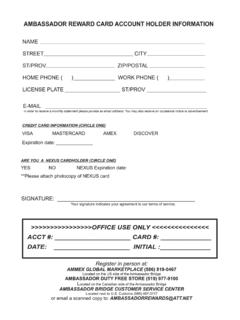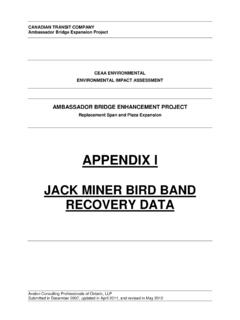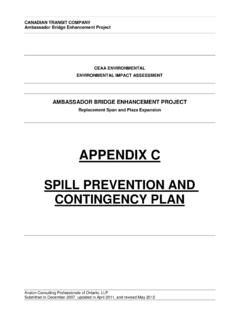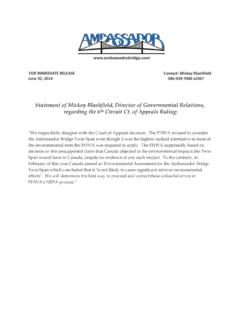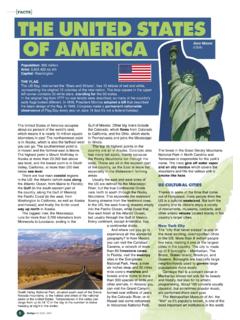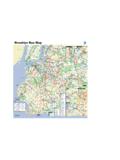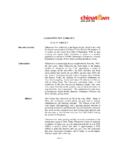Transcription of INTRODUCTION - Ambassador Bridge
1 INTRODUCTION The 1920s inspired those with courage or hard cash (or connections to it) to forge a world that only superlatives could describe. The "War to end all wars" was won, and the powers of politics, science and industry to erase mankind's other ills were in evidence: Women had the vote "devil rum" was shackled two army pilots flew across America non-stop in less than 27 hours now, more Americans lived in cities than on farms (after all, they had seen Paree' ) Jack Benny and Eddie Cantor commanded vaudeville, and F. Scott Fitzgerald, Eugene O'Neill, James Joyce, T. S. Eliot and Sinclair Lewis reshaped our literature Knute Rockne's "Four Horsemen" dominated college gridirons, and the National Football League was formed the world's first commercial radio station, Detroit's 8MK (now WWJ), went on the air, and a patent was sought for an electronic television transmitter.
2 A gay, glorious era for flappers, marathon dances and singing, "Yes, We Have No Bananas". The Teapot Dome oil scandal and the re-emergence of the Ku Klux Klan were forced to compete with the popularity of Babe Ruth and Winnie-the-Pooh. A clumsy attempt to overthrow the German government, the Beer Hall Putsch, was dismissed as the political escapade of an eccentric malcontent, Adolph Hitler. This was also a time for building. Detroit's Penobscot Building, the General Motors Building, the Fisher Building, the Detroit Public Library, the Henry Ford Museum and Greenfield Village, Masonic Auditorium, the Buhl Building and Police Headquarters on Beaubien were only part of the construction that was reshaping Detroit's skyline. In this climate, John W. Austin approached financier Joseph A.
3 Bower, a Detroiter, in Bower's offices at the Liberty National Bank in New York was an officer of the Detroit Graphite Company, and his aim was to secure a contract to paint such a Bridge as might, inevitably, span the Detroit River. Their meeting spawned a remarkable accomplishment - a $ million, privately financed link between the United States and Canada. As the two men met above the din of Manhattan's streetcars and crowds, they talked of heavy construction and high finance. They could not have foreseen their role in a most curious event in Detroit's history. Efforts in Vain The development of Great Lakes shipping, inaugurated by French trappers three centuries before, intensified in the industrial age with the demand for iron ore and other resources of the region.
4 In 1872, the Great Western Railway sent a survey team to Detroit to test the feasibility of a drawbridge, but well-established shipping interests and the ferry boatmen thwarted the plan. Every conceivable site after that triggered a proposition for a Bridge : across Belle Isle, a span from Woodward Avenue to Windsor. The Detroit Board of Commerce formed an International Bridge Committee in 1903. Canada's Border Cities were also anxious to derive the benefits of a link with Detroit. Fowler's Fiasco Shortly after World War I, a prominent New York civil engineer, Charles Evan Fowler, came forward with a proposal to build a Bridge that would accommodate cars, trains, street cars and pedestrians. He organized two companies in the early 1920s - the Canadian Transit Company and the American Transit Company - and had gained the support of both Parliament and Congress for his franchise.
5 His plans, though, were too ambitious. The rail approaches for the $28 million structure would begin a mile inland. Public guarantees for the financing would be needed. Its 110-foot center height would give only marginal clearance for shipping. But still, Detroit must have its Bridge . At this point, Russell T. Scott organized an investment scheme for Fowler's project that not only failed to get the Bridge financed, but devoured $2 million of Scott's own money. Among Fowler's most-ardent supporters was John W. Austin. Determined that the river would be spanned, he approached C. J. Marshall, a principal of the McClintic - Marshall company, a noted Pittsburgh engineering firm, to adopt the project. It was Marshall who arranged Austin's INTRODUCTION to Joseph A.
6 Bower, the banker with a record for snatching success from the jaws of defeat. Bower vs. Smith - the First Encounter After studying the finances and construction of Bridge projects in this country and in Europe, Bower took up the project late in 1924, purchasing options of the stock of the Canadian and American Transit companies (primarily because of the government authorizations). He appointed John Austin treasurer, retained McClintic-Marshall to engineer and build the Bridge , and began securing the necessary endorsements from approving agencies and public bodies. Negotiating any bureaucracy can be intimidating. Joseph Bower was merely proposing to build the longest suspension Bridge in the world. It is a measure of the man that his proposal was accepted by the: President of the United States, Governor -General of Canada, War Department, Canadian Minister of Railways, State of Michigan, Province of Ontario, Lake Carriers Association, Dominion Marine Association, Great Lakes-St.
7 Lawrence Waterways Commission and the Great Lakes Harbor Commission, in addition to the already-held approvals from the Congress and the Canadian Parliament. And on top of this, Bower arranged the financing. After gaining these approvals, Bower applied to local authorities for their consent. The town of Sandwich, Ontario, quickly concurred. Essex County, Ontario, held a spirited referendum in which the Bridge project was approved by the voters. In Detroit, an objection that the proposed Bridge 's 135-foot clearance would limit future navigation was overcome after some protracted discussion. Bower would build his Bridge 152 feet above the Detroit River. Thereupon, the Detroit Common Council unanimously approved the Bridge 's construction. But Detroit Mayor John W.
8 (Johnny) Smith had yet to assert his authority. He cast his veto. The Council overrode it, and he countered in Wayne County Circuit Court with a petition for a restraining order, blocking progress on the Bridge until a popular referendum could be held. Presumably, Joseph Bower and John Austin conferred again. Perhaps they recalled their first meeting several years before. They had come so far. The financing was in hand. The plans were drawn. The authorities had been satisfied. Battle Lines Mayor Smith's opposition to the Bridge was not totally capricious. He argued that, ultimately, the Bridge 's users would pay for its cost and debt service, and would pay a perpetual profit to its owners. BUILD THE Bridge Smith faced re-election, and at the time needed to assert his position as a champion of the electorate.
9 His ally, powerful Robert (Wildflower) Oakman, did not welcome competition for his real estate activities in northwest Detroit from the direction of southwest Ontario. But the pair might have gauged their opponent more warily. Joseph Bower knew that his support among the citizenry was as solid as the planned bedrock foundation of his Bridge . Detroit's political and business leadership was committed to the project. With customary thoroughness, every objection had been refuted or resolved. Bower declined to fight Smith in court. With bravado, he personally assumed the estimated $50,000 cost of the referendum. The issue became a publisher's bonanza. Full-page advertisements darkened newsprint in Detroit with charges and counterclaims. Smith and Oakman warned of the greed of the "Barons of Wall Street"; the signatures of Detroit's first citizens were affixed in public support of the proposition; even merchants closed their ads with the motto: "Build the Bridge ".
10 Public meeting fueled private debates. John Lodge, then a member of the Common Council, became a leading supporter of the Bridge , and saw his mayoral candidacy enhanced. The Esselstyn Affair Finally, the eve of the election, Mayor Smith took to the airwaves for a final condemnation of the proposal. It proved his undoing. As Smith was leaving the studio, he encountered H. H. Esselstyn, a highly respected engineer on the Belle Isle Bridge works, and, at the time, Commissioner of Street Railways. Esselstyn was about to broadcast a statement favorable to the Bridge interests. Smith fired him on the spot. The professional was stunned by the politician's vengeance. Nonetheless, he spoke into the microphone with a calm suited to his considered technical opinions, as he had prepared to do.
